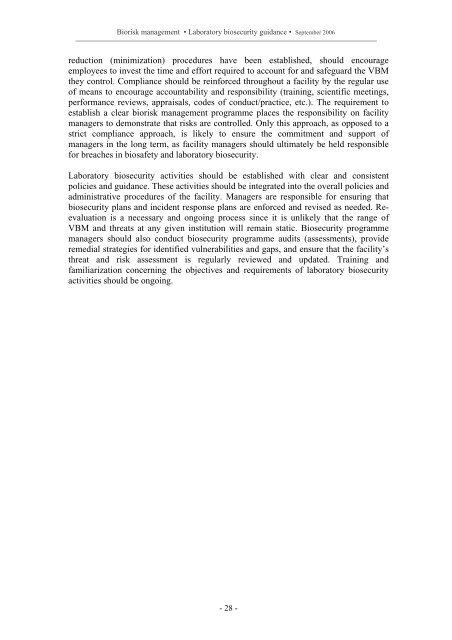Laboratory biosecurity guidance - World Health Organization
Laboratory biosecurity guidance - World Health Organization
Laboratory biosecurity guidance - World Health Organization
Create successful ePaper yourself
Turn your PDF publications into a flip-book with our unique Google optimized e-Paper software.
Biorisk management • <strong>Laboratory</strong> <strong>biosecurity</strong> <strong>guidance</strong> • September 2006<br />
reduction (minimization) procedures have been established, should encourage<br />
employees to invest the time and effort required to account for and safeguard the VBM<br />
they control. Compliance should be reinforced throughout a facility by the regular use<br />
of means to encourage accountability and responsibility (training, scientific meetings,<br />
performance reviews, appraisals, codes of conduct/practice, etc.). The requirement to<br />
establish a clear biorisk management programme places the responsibility on facility<br />
managers to demonstrate that risks are controlled. Only this approach, as opposed to a<br />
strict compliance approach, is likely to ensure the commitment and support of<br />
managers in the long term, as facility managers should ultimately be held responsible<br />
for breaches in biosafety and laboratory <strong>biosecurity</strong>.<br />
<strong>Laboratory</strong> <strong>biosecurity</strong> activities should be established with clear and consistent<br />
policies and <strong>guidance</strong>. These activities should be integrated into the overall policies and<br />
administrative procedures of the facility. Managers are responsible for ensuring that<br />
<strong>biosecurity</strong> plans and incident response plans are enforced and revised as needed. Reevaluation<br />
is a necessary and ongoing process since it is unlikely that the range of<br />
VBM and threats at any given institution will remain static. Biosecurity programme<br />
managers should also conduct <strong>biosecurity</strong> programme audits (assessments), provide<br />
remedial strategies for identified vulnerabilities and gaps, and ensure that the facility’s<br />
threat and risk assessment is regularly reviewed and updated. Training and<br />
familiarization concerning the objectives and requirements of laboratory <strong>biosecurity</strong><br />
activities should be ongoing.<br />
- 28 -

















